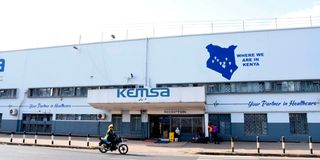Alarm as public hospitals run short of common drugs

Kenya Medical Supplies Authority (KEMSA) Head Office Nairobi at Commercial Street, Industrial Area, Nairobi on February 11, 2022
At least 90 per cent of essential drugs including common antibiotics, painkillers and other inexpensive, yet critical medicine are out of stock at the country’s national drug distributor, a leaked report has shown.
The most affected lot will be Kenyans who mostly frequent public hospitals who will now not be able to access common drugs including paracetamol, ibuprofen and azithromycin.
As if to add salt to injury, Kenya’s stocks of surgeon gloves, syringes and cotton wools, bandages and feeding tubes are also out of stock, denying hospitals basic and essential commodities necessary for everyday use.
In the list prepared by the Kenya Medical Supplies Agency (Kemsa) and seen by the Saturday Nation, over 461 drugs are out of stock, pointing to a bigger problem that the country is about to face.
Asked about the shortage, Kemsa acting Chief Executive Officer Terry Ramadhani cited supply chain disruptions, but insisted that orders for key medicines had already been made.
Also Read: Kemsa caught up in new Sh4bn scandal
“There are many factors that drive delays in deliveries, which could be disruptions in the supply chain or delays in payments to suppliers due to our current cash flow challenges. KEMSA operates a model whereby we stock items in the essential list as defined by the Kenya Essential Medicines list and the quantifications are driven by demand,” she said.
She continues: “We have reviewed our inventory to only focus on VTA (Vitals, Tracers and Class A items) to improve on the availability of essential products and get our order fill rate to above 80 per cent, as you can appreciate this is a work in progress and we are seeing incremental progress from an order fill rate of 18 per cent in 2021 to a fill rate of 59 per cent currently.”
In the list Ms Ramadhani provided, however, compared to demand and supply, some key drugs, including Amoxicilin capsules, Ceftriaxone injections, paracetamol suspension and tetracycline ointment are out of stock.
The leaked Kemsa list seen by the Sunday Nation shows patients currently in need of Azithromycin which is a drug used to treat bacterial infections, including pneumonia, sexually transmitted diseases (STD) and infections of the ears, lungs, and reproductive organs will have to wait since there is none left at the Kemsa stores.
With a monthly consumption of 144,089 packs per month, there is a likelihood that many Kenyans will go without the drugs.
Amoxicillin, which is a penicillin antibiotic used for the treatment of bacterial infections including chest infections and pneumonia and stomach ulcers, is also not available.
Hospitals and counties ordering these drugs will have to wait for long until they are made available by Kemsa or sourced from other suppliers.
Also, there is a shortage of epidural catheters, which are used for pain control during childbirth.
The catheters are used for other surgeries as well, which means that many patients may end up not using other options for pain control.
In the list, the country is also experiencing a shortage of Foley catheters – both the three-way and the two used by patients when irrigating their bladder. It is anticipated to prevent and manage blood clots in the bladder.
This is happening at a time that the country is also in demand of over 500,000 catheters in a month, hence many are bound to suffer.
In a month, Kenya demands 589, 206 bottles of water for injection.
From the list in our possession, there is no single bottle in the warehouse, which means that hospitals will lack vessels to dilute and prepare medicines before use.
Water for injection is used for dissolving and diluting drugs, which are meant for parenteral use. It is also used to wash small wounds and during minor surgical procedures.
The country also lacks Misoprostol tablets used in the treatment of stomach ulcers.
This is one of the most common drugs for pain with the country consuming close to over 300,000 tablets per month.
Cholera vaccines and chlorine tablets used for water purification and cleaning food preparation surfaces, equipment disinfection, mop soaking and bleaching are also out of stock.
Also, co-trimoxazole tablet, which is normally used for the treatment of ‘travellers diarrhea’, is not available considering that 104,875 tablets are consumed per month in the country.
The details come as Nairobi Country is leading with the number of cholera deaths at 74 with 22 out of 47 counties recording cases.
This cold season, many Kenyans are affected by the flu, with those with respiratory diseases suffering the most. For this, they need Nebulizers to stabilise, but there is no stock in the store yet over 200,000 are consumed in a month in the country.
Flucloxacillin Capsules for skin and wound infections, bone infections (osteomyelitis) and treatment of ear infections in children is also not available.
In Kenya, stock outs of essential drugs and commodities is not news, with many pointing fingers at Kemsa which is responsible for the procurement, distribution and storage of medicines and health products to county and public hospitals.
Shortage of essential medicines is coupled with a combination of factors including poor investment in personnel and infrastructure, inadequate resources, and corruption and mismanagement of funds within institutions
This then raises question, just what is happening at Kemsa? Could it be that the government has withdrawn the procurement services from Kemsa? Or is it that the institution does not have the resources to procure the drugs? Or, has the procurement been done and is yet to be delivered?
Health Cabinet Secretary Susan Nakhumicha had earlier this year indicated that the Ministry is implementing a raft of proposed reforms which will see Kemsa lose its procurement function which was to be transferred to other entities.
In efforts to improve how the entity operates, she said, Kemsa will only be in charge of warehousing and distribution.
“If Kemsa is unable to do procurement, then we will have to [delegate the role] to experts, leaving Kemsa with warehousing and distribution,” Ms Nakhumicha said adding that Kemsa has the capacity for warehousing and distribution and not procurement.
“We are rethinking what strategies to use in terms of procurement to meet the basic needs of Kenyans,” she said.





